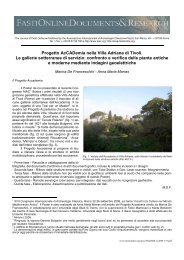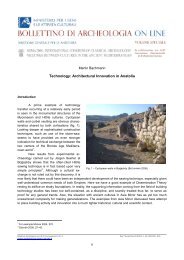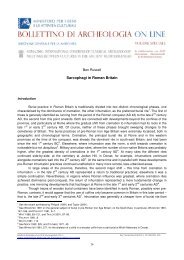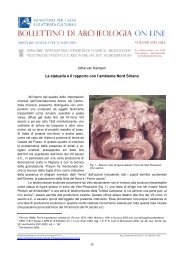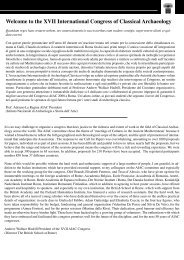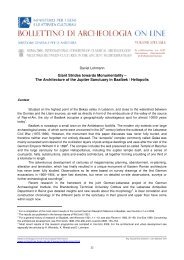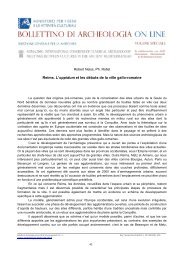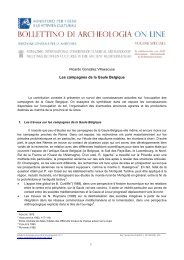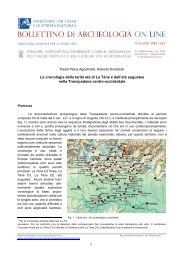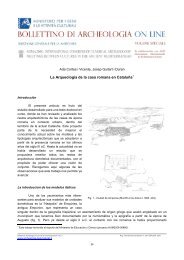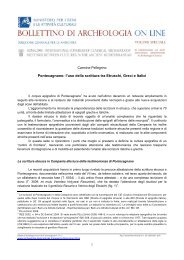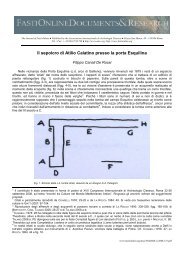Tabula Siarensis - Bollettino di archeologia on line - Ministero per i ...
Tabula Siarensis - Bollettino di archeologia on line - Ministero per i ...
Tabula Siarensis - Bollettino di archeologia on line - Ministero per i ...
Create successful ePaper yourself
Turn your PDF publications into a flip-book with our unique Google optimized e-Paper software.
BOLLETTINO DI ARCHEOLOGIA ON LINE II, 2011/2-3<br />
n<strong>on</strong> magis laudati<strong>on</strong>em quam vitae totius or<str<strong>on</strong>g>di</str<strong>on</strong>g>nem et virtutis eius verum testim<strong>on</strong>ium, cioè “n<strong>on</strong><br />
tanto la lode, quanto lo svolgimento <str<strong>on</strong>g>di</str<strong>on</strong>g> tutta la vita (<str<strong>on</strong>g>di</str<strong>on</strong>g> Germanico) e la vera testim<strong>on</strong>ianza della<br />
sua virtù”. 35<br />
LINEA 8 Dopo il verbo alla terza <strong>per</strong>s<strong>on</strong>a, verosimilmente un c<strong>on</strong>giuntivo im<strong>per</strong>fetto (es: [fie]ret),<br />
si è aggiunta una virgola, dato che l’avverbio deinde evidenzia il seguito <str<strong>on</strong>g>di</str<strong>on</strong>g> un’enumerazi<strong>on</strong>e,<br />
<str<strong>on</strong>g>di</str<strong>on</strong>g> un elenco, dove è affermata una vicinanza a qualcosa o a qualcuno: ]ret, proxume deinde ab<br />
e[o loco in quo (?)...], “..., poi vicinissimo a [quel luogo in cui (?) ...]”. Potrebbe trattarsi del<br />
suggerimento del luogo in circo Flaminio in cui e<str<strong>on</strong>g>di</str<strong>on</strong>g>ficare l’arco (v. <strong>line</strong>a 16).<br />
LINEA 9<br />
L’ablativo partu, preceduto da un aggettivo su<strong>per</strong>lativo ([—-]ssimo) e ulteriormente definito<br />
da rei publicae, può significare “<strong>per</strong> la [-su<strong>per</strong>l.-] c<strong>on</strong>quista dello stato”, ma anche “<strong>per</strong> la<br />
[-su<strong>per</strong>l.-] prole dello stato”.<br />
A partire dalla <strong>line</strong>a 10, fino alla fine del nostro frammento (<strong>line</strong>a 22), il testo è c<strong>on</strong>fr<strong>on</strong>tabile,<br />
in parte sovrapp<strong>on</strong>ibile e integrabile c<strong>on</strong> quello <str<strong>on</strong>g>di</str<strong>on</strong>g> Tab. Siar. I, 1-19.<br />
Le <strong>line</strong>e 10-15, corrisp<strong>on</strong>denti a Tab. Siar. I, 1-8, c<strong>on</strong>teng<strong>on</strong>o la parte finale della relatio,<br />
in cui il Senato, prima <str<strong>on</strong>g>di</str<strong>on</strong>g> stabilire gli <strong>on</strong>ori funebri a Germanico, alcuni dei quali probabilmente<br />
s<strong>on</strong>o già stati suggeriti dal relatore, 36 decide <str<strong>on</strong>g>di</str<strong>on</strong>g> sentire il parere <str<strong>on</strong>g>di</str<strong>on</strong>g> Tiberio, e a questo scopo gli<br />
c<strong>on</strong>segna una relazi<strong>on</strong>e c<strong>on</strong>tenente le <str<strong>on</strong>g>di</str<strong>on</strong>g>verse opini<strong>on</strong>i dei senatori. L’im<strong>per</strong>atore coinvolge nella<br />
scelta finale degli <strong>on</strong>ori la madre Livia, il figlio Druso e la madre <str<strong>on</strong>g>di</str<strong>on</strong>g> Germanico, Ant<strong>on</strong>ia. 37<br />
LINEE 10-11 = Tab. Siar. I, 1-3<br />
Anche il testo della <strong>line</strong>a 10 è ine<str<strong>on</strong>g>di</str<strong>on</strong>g>to: nella lacuna sin. dovrebbe trovar posto soltanto<br />
una ]n[, lettera isolata <str<strong>on</strong>g>di</str<strong>on</strong>g> Tab. Siar. I, 1.<br />
La restituzi<strong>on</strong>e <str<strong>on</strong>g>di</str<strong>on</strong>g> Tab. Siar. I, 1-4 è già data come problematica, e solo a titolo orientativo, da<br />
G<strong>on</strong>zález: 38 [quod ... v(erba) f(ecere) de c<strong>on</strong>servanda memoria Germanici Caesaris qui mori<br />
nun]quam debuit [... Lo stu<str<strong>on</strong>g>di</str<strong>on</strong>g>oso spagnolo raccoglie anche la versi<strong>on</strong>e <str<strong>on</strong>g>di</str<strong>on</strong>g> Crawford: 39 [quod...<br />
v(erba) f(ecere) de c<strong>on</strong>servanda memoria Germanici Caesaris qui mortem obire nu]nquam debuit,<br />
[cum...<br />
Ora, le nostre <strong>line</strong>e 10-11 (- - -]a optime meritis princip[is nostri - - -/ nunquam debuit<br />
- - -]) si collegano a Tab. Siar. I, 2 c<strong>on</strong> il senso “... nel modo migliore, <strong>per</strong> i meriti del [nostro]<br />
principe, n<strong>on</strong> dovette mai ...”. Sembra <strong>per</strong>dere valore l’integrazi<strong>on</strong>e [qui mori]: la frase retta<br />
dal verbo debuit, riferito a Germanico, dovrebbe risolversi nella breve lacuna (ca. 10 lettere)<br />
alla fine della <strong>line</strong>a 10 o in quella successiva, solo al termine della quale si inserisce l’espressi<strong>on</strong>e<br />
infinitiva, anch’essa ine<str<strong>on</strong>g>di</str<strong>on</strong>g>ta, meritis Germani]ci Caesaris decernere. Hi[s? igitur? Questa<br />
espressi<strong>on</strong>e n<strong>on</strong> necessariamente <str<strong>on</strong>g>di</str<strong>on</strong>g>penderebbe dal debuit della negativa precedente, anche a<br />
causa della lunghezza della lacuna. In questo punto, meritis potrebbe essere inteso, allo stesso<br />
modo che nella riga precedente, come sostantivo, e n<strong>on</strong> come participio passato; così forse si<br />
potrebbe eliminare la parola h<strong>on</strong>oribus, d’integrazi<strong>on</strong>e in Tab. Siar. I, 3. Avremmo allora: “...<br />
nel modo migliore, <strong>per</strong> i meriti del nostro principe (scil. Tiberio).../ n<strong>on</strong> dovette mai ...; ... scegliere<br />
tra i meriti <str<strong>on</strong>g>di</str<strong>on</strong>g> Germanico Cesare. A questi allora ...”.<br />
La lunga lacuna della <strong>line</strong>a 11 potrebbe giustamente c<strong>on</strong>tenere l’integrazi<strong>on</strong>e proposta<br />
da Tab. Siar. I, 2 (senatus censuit faciendum esse s. c.), coor<str<strong>on</strong>g>di</str<strong>on</strong>g>nata, anche se un po’ a fatica, me-<br />
35) Sappiamo, più avanti nel testo (Tab. Siar. IIb, 11-27), che il Senato or<str<strong>on</strong>g>di</str<strong>on</strong>g>nerà <str<strong>on</strong>g>di</str<strong>on</strong>g> pubblicare in br<strong>on</strong>zo, nel portico del tempio<br />
<str<strong>on</strong>g>di</str<strong>on</strong>g> Apollo Palatino, il senatoc<strong>on</strong>sulto <str<strong>on</strong>g>di</str<strong>on</strong>g> fine <str<strong>on</strong>g>di</str<strong>on</strong>g>cembre insieme a quello del 16 <str<strong>on</strong>g>di</str<strong>on</strong>g>cembre e alle due laudati<strong>on</strong>es. Tale pubblicazi<strong>on</strong>e,<br />
il più possibile completa, doveva servire <strong>per</strong> tranquillizzare il popolo romano riguardo all’affetto dell’im<strong>per</strong>atore e <str<strong>on</strong>g>di</str<strong>on</strong>g> suo figlio<br />
nei c<strong>on</strong>fr<strong>on</strong>ti del defunto, e a smorzare i sospetti sulla morte <strong>per</strong> avvelenamento. Nei municipi e nelle province circolerà, c<strong>on</strong><br />
un fine esclusivamente ideologico, una forma c<strong>on</strong>densata, <str<strong>on</strong>g>di</str<strong>on</strong>g>ffusa nel 20 d.C., quella appunto attestata dalla Tab. Siar. e dal<br />
frammento del Museo <str<strong>on</strong>g>di</str<strong>on</strong>g> Perugia, cfr. GONZáLEZ 2008, p. 148.<br />
36) Anche se l’espressi<strong>on</strong>e quos habendos esse censebat senatus farebbe pensare a un senatoc<strong>on</strong>sulto votato, cfr. GONZáLEZ<br />
2002, p. 145.<br />
37) Forse la decisi<strong>on</strong>e del Senato <str<strong>on</strong>g>di</str<strong>on</strong>g> sentire Tiberio era stata presa in un senatoc<strong>on</strong>sulto anteriore, magari in quello del 16 <str<strong>on</strong>g>di</str<strong>on</strong>g>cembre,<br />
cfr. GONZáLEZ 2002, pp. 299 s., 317.<br />
38) GONZáLEZ 2002, pp. 299, 317 s.<br />
39) CRAwFORD 1996, p. 515.<br />
www.<str<strong>on</strong>g>archeologia</str<strong>on</strong>g>.beniculturali.it<br />
Reg. Tribunale Roma 05.08.2010 n.30 ISSN 2039 - 0076<br />
11



